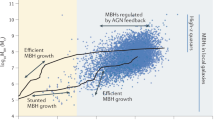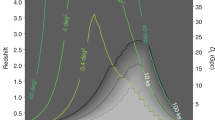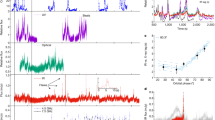Abstract
Recent developments have ushered in a new era in the field of black-hole astrophysics, providing a direct view of the remarkable environment near black-hole event horizons. These observations have enabled astronomers to confirm long-standing ideas on the physics of gas flowing into black holes with temperatures that are hundreds of times greater than at the centre of the Sun. At the same time, the observations have conclusively shown that light rays near a black hole experience large deflections that cause a dark shadow in the centre of the image, an effect predicted by Einstein’s theory of general relativity. With further investment, this field is poised to deliver decades of advances in our understanding of gravity and black holes through stringent tests of general relativity, as well as insights into the role of black holes as the central engines powering a wide range of astronomical phenomena.
This is a preview of subscription content, access via your institution
Access options
Access Nature and 54 other Nature Portfolio journals
Get Nature+, our best-value online-access subscription
$29.99 / 30 days
cancel any time
Subscribe to this journal
Receive 51 print issues and online access
$199.00 per year
only $3.90 per issue
Buy this article
- Purchase on Springer Link
- Instant access to full article PDF
Prices may be subject to local taxes which are calculated during checkout




Similar content being viewed by others
Data availability
EHT data for Fig. 1 are available at https://github.com/eventhorizontelescope.
Code availability
Figure 1 and the right panel of Fig. 2 were created using the ehtim (eht-imaging) software package90 which is available at https://github.com/achael/eht-imaging.
References
Schwarzschild, K. On the gravitational field of a mass point according to Einstein’s theory. Abh. Konigl. Preuss. Akad. Wiss. Berlin 1916, 189–196 (1916).
Kerr, R. P. Gravitational field of a spinning mass as an example of algebraically special metrics. Phys. Rev. Lett. 11, 237–238 (1963). An exact analytical solution of general relativity describing the most general spinning uncharged black hole.
Misner, C. W., Thorne, K. S. & Wheeler, J. A. Gravitation (Princeton Univ. Press, 2018).
Michell, J. On the means of discovering the distance, magnitude, &c. of the fixed stars, in consequence of the diminution of the velocity of their light, in case such a diminution should be found to take place in any of them, and such other data should be procured from observations, as would be farther necessary for that purpose. By the Rev. John Michell, B. D. F. R. S. in a letter to Henry Cavendish, Esq. F. R. S. and A. S. Phil. Trans. R. Soc. Lond. 74, 35–57 (1784).
Laplace, P. S. Beweis des Satzes, dass die anziehende Kraft bey einem Weltkörper so groß seyn könne, dass das Licht davon nicht ausströmen kann. Allg. Geogr. Ephemer. 4, 1–6 (1799).
Thorne, K. S. Black Holes and Time Warps: Einstein’s Outrageous Legacy (W. W. Norton, 1994).
Begelman, M. & Rees, M. Gravity’s Fatal Attraction (Cambridge Univ. Press, 2020).
Penrose, R. Gravitational collapse and space-time singularities. Phys. Rev. Lett. 14, 57–59 (1965). Mathematical proof that black-hole formation is inevitable in general relativity from certain generic initial conditions.
Hawking, S. W. Particle creation by black holes. Commun. Math. Phys. 43, 199–220 (1975).
Schmidt, M. 3C 273 : a star-like object with large red-shift. Nature 197, 1040 (1963). Discovery that the quasar 3C 273, later identified as an accreting supermassive black hole, is at a redshift of 0.158 and therefore very distant from our Galaxy and highly luminous.
Salpeter, E. E. Accretion of interstellar matter by massive objects. Astrophys. J. 140, 796–800 (1964).
Luminet, J.-P. Image of a spherical black hole with thin accretion disk. Astron. Astrophys. 75, 228–235 (1979).
Falcke, H., Melia, F. & Agol, E. Viewing the shadow of the black hole at the Galactic Center. Astrophys. J. Lett. 528, 13–16 (2000).
Event Horizon Telescope Collaboration First M87 Event Horizon Telescope results. I. The shadow of the supermassive black hole. Astrophys. J. Lett. 875, 1 (2019). Landmark experiment with the Event Horizon Telescope that obtained the image of the supermassive black hole M87* and confirmed the predicted black-hole shadow.
Event Horizon Telescope Collaboration First Sagittarius A* Event Horizon Telescope results. I. The shadow of the supermassive black hole in the center of the Milky Way. Astrophys. J. Lett. 930, 12 (2022).
Eckart, A. & Genzel, R. Observations of stellar proper motions near the Galactic Centre. Nature 383, 415–417 (1996).
Ghez, A. M., Klein, B. L., Morris, M. & Becklin, E. E. High proper-motion stars in the vicinity of Sagittarius A*: evidence for a supermassive black hole at the center of our Galaxy. Astrophys. J. 509, 678–686 (1998).
Ghez, A. M., Morris, M., Becklin, E. E., Tanner, A. & Kremenek, T. The accelerations of stars orbiting the Milky Way’s central black hole. Nature 407, 349–351 (2000). Measurement of the accelerations of stars orbiting the object Sagittarius A* at the centre of the Galaxy.
Schödel, R. et al. A star in a 15.2-year orbit around the supermassive black hole at the centre of the Milky Way. Nature 419, 694–696 (2002). Landmark study that reported a nearly complete orbit of a star at the centre of our Galaxy and proved beyond reasonable doubt that Sagittarius A* is a four-million-solar-mass black hole.
Ghez, A. M. et al. Stellar orbits around the Galactic Center black hole. Astrophys. J. 620, 744–757 (2005).
Gebhardt, K. et al. The Black Hole mass in M87 from Gemini/NIFS adaptive optics observations. Astrophys. J. 729, 119 (2011).
Hees, A. et al. Testing general relativity with stellar orbits around the supermassive black hole in our Galactic Center. Phys. Rev. Lett. 118, 211101 (2017).
GRAVITY Collaboration Detection of the gravitational redshift in the orbit of the star S2 near the Galactic Centre massive black hole. Astron. Astrophys. 615, 15 (2018).
Do, T. et al. Relativistic redshift of the star S0-2 orbiting the Galactic Center supermassive black hole. Science 365, 664–668 (2019).
GRAVITY Collaboration Detection of the Schwarzschild precession in the orbit of the star S2 near the Galactic Centre massive black hole. Astron. Astrophys. 636, 5 (2020).
Di Matteo, T., Springel, V. & Hernquist, L. Energy input from quasars regulates the growth and activity of black holes and their host galaxies. Nature 433, 604–607 (2005).
Brüggen, M. & Kaiser, C. R. Hot bubbles from active galactic nuclei as a heat source in cooling-flow clusters. Nature 418, 301–303 (2002).
Cattaneo, A. et al. The role of black holes in galaxy formation and evolution. Nature 460, 213–219 (2009).
Fabian, A. C. Observational evidence of active galactic nuclei feedback. Annu. Rev. Astron. Astrophys. 50, 455–489 (2012).
Balbus, S. A. & Hawley, J. F. A powerful local shear instability in weakly magnetized disks. I. Linear analysis. Astrophys. J. 376, 214–222 (1991).
Shakura, N. I. & Sunyaev, R. A. Black holes in binary systems. Observational appearance. Astron. Astrophys. 24, 337–355 (1973).
Novikov, I. D. & Thorne, K. S. in Black Holes (Les Astres Occlus) (eds DeWitt, C. & DeWitt, B.) 343–450 (Gordon & Breach, 1973).
Esin, A. A., McClintock, J. E. & Narayan, R. Advection-dominated accretion and the spectral states of black hole X-ray binaries: application to Nova Muscae 1991. Astrophys. J. 489, 865–889 (1997).
Fabian, A. C. & Canizares, C. R. Do massive black holes reside in elliptical galaxies? Nature 333, 829–831 (1988).
Ho, L. C. Nuclear activity in nearby galaxies. Ann. Rev. Astron. Astrophys. 46, 475–539 (2008).
Goldwurm, A. et al. Possible evidence against a massive black hole at the Galactic Centre. Nature 371, 589–591 (1994).
Grindlay, J. E. Black holes take centre stage? Nature 371, 561–562 (1994).
Krichbaum, T. P. et al. VLBI observations of the Galactic Center source SGR A* at 86 GHz and 215 GHz. Astron. Astrophys. 335, 106–110 (1998).
Shen, Z.-Q., Lo, K. Y., Liang, M. C., Ho, P. T. P. & Zhao, J.-H. A size of ~1 au for the radio source Sgr A* at the centre of the Milky Way. Nature 438, 62–64 (2005).
Yuan, F. & Narayan, R. Hot accretion flows around black holes. Ann. Rev. Astron. Astrophys. 52, 529–588 (2014).
Shapiro, S. L., Lightman, A. P. & Eardley, D. M. A two-temperature accretion disk model for Cygnus X-1: structure and spectrum. Astrophys. J. 204, 187–199 (1976).
Pringle, J. E. Thermal instabilities in accretion discs. Mon. Not. R. Astron. Soc. 177, 65–71 (1976).
Piran, T. The role of viscosity and cooling mechanisms in the stability of accretion disks. Astrophys. J. 221, 652–660 (1978).
Ichimaru, S. Bimodal behavior of accretion disks: theory and application to Cygnus X-1 transitions. Astrophys. J. 214, 840–855 (1977).
Rees, M. J., Begelman, M. C., Blandford, R. D. & Phinney, E. S. Ion-supported tori and the origin of radio jets. Nature 295, 17–21 (1982).
Narayan, R. & Yi, I. Advection-dominated accretion: a self-similar solution. Astrophys. J. Lett. 428, 13–16 (1994).
Narayan, R. & Yi, I. Advection-dominated accretion: underfed black holes and neutron stars. Astrophys. J. 452, 710–735 (1995).
Abramowicz, M. A., Chen, X., Kato, S., Lasota, J.-P. & Regev, O. Thermal equilibria of accretion disks. Astrophys. J. Lett. 438, 37–39 (1995).
Narayan, R., Mahadevan, R. & Quataert, E. in Theory of Black Hole Accretion Disks (eds Abramowicz, M. A. et al.) 148–182 (Cambridge Univ. Press, 1998).
Narayan, R., Yi, I. & Mahadevan, R. Explaining the spectrum of Sagittarius A* with a model of an accreting black hole. Nature 374, 623–625 (1995). Application of the hot-accretion-flow model to an astrophysical black hole, Sagittarius A* at our Galactic Centre.
Reynolds, C. S., Di Matteo, T., Fabian, A. C., Hwang, U. & Canizares, C. R. The ‘quiescent’ black hole in M87. Mon. Not. R. Astron. Soc. 283, 111–116 (1996).
Thompson, A. R., Moran, J. M. & Swenson, G. W. Interferometry and Synthesis in Radio Astronomy 3rd edn (Springer, 2017).
Eisenhauer, F. et al. GRAVITY: getting to the event horizon of Sgr A*. In Optical and Infrared Interferometry Society of Photo-Optical Instrumentation Engineers Conference Series Vol. 7013 (eds Schöller, M. et al.) 70132 (SPIE, 2008).
Walker, R. C., Hardee, P. E., Davies, F. B., Ly, C. & Junor, W. The structure and dynamics of the subparsec jet in M87 based on 50 VLBA observations over 17 Years at 43 GHz. Astrophys. J. 855, 128 (2018).
Baganoff, F. K. et al. Rapid X-ray flaring from the direction of the supermassive black hole at the Galactic Centre. Nature 413, 45–48 (2001).
Genzel, R. et al. Near-infrared flares from accreting gas around the supermassive black hole at the Galactic Centre. Nature 425, 934–937 (2003).
Ghez, A. M. et al. Variable infrared emission from the supermassive black hole at the center of the Milky Way. Astrophys. J. Lett. 601, 159–162 (2004).
GRAVITY Collaboration Detection of orbital motions near the last stable circular orbit of the massive black hole SgrA*. Astron. Astrophys. 618, 10 (2018). Detection of looped clockwise motion of infrared-emitting gas around the Galactic Centre black hole Sagittarius A*.
Gammie, C. F., McKinney, J. C. & Tóth, G. HARM: a numerical scheme for general relativistic magnetohydrodynamics. Astrophys. J. 589, 444–457 (2003).
De Villiers, J.-P. & Hawley, J. F. A numerical method for general relativistic magnetohydrodynamics. Astrophys. J. 589, 458–480 (2003).
Mościbrodzka, M., Gammie, C. F., Dolence, J. C., Shiokawa, H. & Leung, P. K. Radiative models of SGR A* from GRMHD simulations. Astrophys. J. 706, 497–507 (2009).
Dexter, J., Agol, E., Fragile, P. C. & McKinney, J. C. The submillimeter bump in Sgr A* from relativistic MHD simulations. Astrophys. J. 717, 1092–1104 (2010).
Event Horizon Telescope Collaboration First Sagittarius A* Event Horizon Telescope results. V. Testing astrophysical models of the Galactic Center black hole. Astrophys. J. Lett. 930, 16 (2022).
Event Horizon Telescope Collaboration First M87 Event Horizon Telescope results. VIII. Magnetic field structure near the event horizon. Astrophys. J. Lett. 910, 13 (2021).
Agol, E. Sagittarius A* polarization: no advection-dominated accretion flow, low accretion rate, and nonthermal synchrotron emission. Astrophys. J. Lett. 538, 121–124 (2000).
Quataert, E. & Gruzinov, A. Constraining the accretion rate onto Sagittarius A* using linear polarization. Astrophys. J. 545, 842–846 (2000).
Event Horizon Telescope Collaboration First Sagittarius A* Event Horizon Telescope results. VI. Testing the black hole metric. Astrophys. J. Lett. 930, 17 (2022).
Newman, E. T. et al. Metric of a rotating, charged mass. J. Math. Phys. 6, 918–919 (1965).
Blandford, R. D. & Znajek, R. L. Electromagnetic extraction of energy from Kerr black holes. Mon. Not. R. Astron. Soc. 179, 433–456 (1977). Demonstration that magnetic fields threading the black-hole horizon can extract rotational energy of the black hole, powering relativistic jets.
Darwin, C. The gravity field of a particle. Proc. R. Soc. Lond. Ser. A 249, 180–194 (1959).
Bardeen, J. M. in Black Holes (Les Astres Occlus) (eds DeWitt, C. & DeWitt, B.) 241–289 (Gordon & Breach, 1973).
Johnson, M. D. & Lupsasca, A. et al. Universal interferometric signatures of a black hole’s photon ring. Sci. Adv. 6, 1310 (2020). Description of the formation of a set of nested self-similar subrings by black-hole lensing, and discussion of how the subrings could be disentangled in the image via interferometry.
Broderick, A. E., Johannsen, T., Loeb, A. & Psaltis, D. Testing the no-hair theorem with Event Horizon Telescope observations of Sagittarius A*. Astrophys. J. 784, 7 (2014).
Psaltis, D. et al. Gravitational test beyond the first post-Newtonian order with the shadow of the M87 black hole. Phys. Rev. Lett. 125, 141104 (2020).
Chael, A., Johnson, M. D. & Lupsasca, A. Observing the inner shadow of a black hole: a direct view of the event horizon. Astrophys. J. 918, 6 (2021).
Johannsen, T. & Psaltis, D. Testing the no-hair theorem with observations in the electromagnetic spectrum. II. Black hole images. Astrophys. J. 718, 446–454 (2010).
Gralla, S. E., Lupsasca, A. & Marrone, D. P. The shape of the black hole photon ring: a precise test of strong-field general relativity. Phys. Rev. D 102, 124004 (2020).
Penrose, R. Gravitational collapse: the role of general relativity. Nuovo Cimento Rivista Serie 1, 252 (1969).
Bardeen, J. M., Press, W. H. & Teukolsky, S. A. Rotating black holes: locally nonrotating frames, energy extraction, and scalar synchrotron radiation. Astrophys. J. 178, 347–370 (1972).
Semenov, V., Dyadechkin, S. & Punsly, B. Simulations of jets driven by black hole rotation. Science 305, 978–980 (2004).
Tchekhovskoy, A., Narayan, R. & McKinney, J. C. Efficient generation of jets from magnetically arrested accretion on a rapidly spinning black hole. Mon. Not. R. Astron. Soc. 418, 79–83 (2011).
Ricarte, A., Palumbo, D. C. M., Narayan, R., Roelofs, F. & Emami, R. Observational signatures of frame dragging in strong gravity. Astrophys. J. Lett. 941, L12 (2022).
Falcke, H. & Markoff, S. The jet model for Sgr A*: radio and X-ray spectrum. Astron. Astrophys. 362, 113–118 (2000).
Yusef-Zadeh, F., Roberts, D., Wardle, M., Heinke, C. O. & Bower, G. C. Flaring activity of Sagittarius A* at 43 and 22 GHz: evidence for expanding hot plasma. Astrophys. J. 650, 189–194 (2006).
Brinkerink, C. D., Falcke, H., Law, C. J., Barkats, D. & Bower, G. C. et al. ALMA and VLA measurements of frequency-dependent time lags in Sagittarius A*: evidence for a relativistic outflow. Astron. Astrophys. 576, 41 (2015).
Psaltis, D., Wex, N. & Kramer, M. A quantitative test of the no-hair theorem with Sgr A* using stars, pulsars, and the Event Horizon Telescope. Astrophys. J. 818, 121 (2016).
Arzoumanian, Z. et al. The NANOGrav 12.5 yr data set: search for an isotropic stochastic gravitational-wave background. Astrophys. J. Lett. 905, 34 (2020).
Kalogera, V. et al. The next generation global gravitational wave observatory: the science book. Preprint at https://arxiv.org/abs/2111.06990 (2021).
Amaro-Seoane, P. et al. Laser Interferometer Space Antenna. Preprint at https://arxiv.org/abs/1702.00786 (2017).
Chael, A. A. et al. Interferometric imaging directly with closure phases and closure amplitudes. Astrophys. J. 857, 23 (2018).
Event Horizon Telescope Collaboration First M87 Event Horizon Telescope results. IV. Imaging the central supermassive black hole. Astrophys. J. Lett. 875, 4 (2019).
Event Horizon Telescope Collaboration First M87 Event Horizon Telescope results. VII. Polarization of the ring. Astrophys. J. Lett. 910, 12 (2021).
Event Horizon Telescope Collaboration First Sagittarius A* Event Horizon Telescope results. III. Imaging of the Galactic Center supermassive black hole. Astrophys. J. Lett. 930, 14 (2022).
Goddi, C. et al. Polarimetric properties of Event Horizon Telescope targets from ALMA. Astrophys. J. Lett. 910, 14 (2021).
Kravchenko, E. et al. Linear polarization in the nucleus of M87 at 7 mm and 1.3 cm. Astron. Astrophys. 637, 6 (2020).
Owen, F. N., Eilek, J. A. & Kassim, N. E. M87 at 90 centimeters: a different picture. Astrophys. J. 543, 611–619 (2000).
Author information
Authors and Affiliations
Contributions
R.N. and E.Q. contributed equally to all aspects of the paper.
Corresponding author
Ethics declarations
Competing interests
The authors declare no competing interests.
Peer review
Peer review information
Nature thanks the anonymous reviewers for their contribution to the peer review of this work.
Additional information
Publisher’s note Springer Nature remains neutral with regard to jurisdictional claims in published maps and institutional affiliations.
Rights and permissions
Springer Nature or its licensor (e.g. a society or other partner) holds exclusive rights to this article under a publishing agreement with the author(s) or other rightsholder(s); author self-archiving of the accepted manuscript version of this article is solely governed by the terms of such publishing agreement and applicable law.
About this article
Cite this article
Narayan, R., Quataert, E. Black holes up close. Nature 615, 597–604 (2023). https://doi.org/10.1038/s41586-023-05768-4
Received:
Accepted:
Published:
Issue Date:
DOI: https://doi.org/10.1038/s41586-023-05768-4
Comments
By submitting a comment you agree to abide by our Terms and Community Guidelines. If you find something abusive or that does not comply with our terms or guidelines please flag it as inappropriate.



